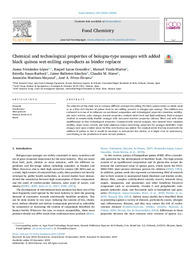Por favor, use este identificador para citar o enlazar este ítem:
https://hdl.handle.net/11000/30596Registro completo de metadatos
| Campo DC | Valor | Lengua/Idioma |
|---|---|---|
| dc.contributor.author | Fernandez-Lopez, Juana | - |
| dc.contributor.author | Lucas González, Raquel | - |
| dc.contributor.author | Viuda-Martos, Manuel | - |
| dc.contributor.author | Sayas-Barberá, Estrella | - |
| dc.contributor.author | Ballester-Sánchez, Jaime | - |
| dc.contributor.author | Haros, Claudia Monika | - |
| dc.contributor.author | Martínez Mayoral, María Asunción | - |
| dc.contributor.author | Pérez-Alvarez, José Angel | - |
| dc.contributor.other | Departamentos de la UMH::Tecnología Agroalimentaria | es_ES |
| dc.date.accessioned | 2024-01-24T09:11:07Z | - |
| dc.date.available | 2024-01-24T09:11:07Z | - |
| dc.date.created | 2019-11 | - |
| dc.identifier.citation | Food Chemistry Volume 310, 25 April 2020 | es_ES |
| dc.identifier.issn | 0308-8146 | - |
| dc.identifier.uri | https://hdl.handle.net/11000/30596 | - |
| dc.description.abstract | The objective of this study was to evaluate different strategies for adding 3% black quinoa (either as whole seeds or as a fiber-rich fraction of quinoa from its wet-milling process) to bologna-type sausage. This addition was evaluated in terms of its influence on nutritional composition and technological properties (emulsion stability, pH, water activity, color changes, textural properties, residual nitrite level and lipid oxidation). Both strategies resulted in commercially feasible sausages with increased nutritive properties (dietary fiber) and with some modifications in their technological properties. Compared with control sausages, they showed better emulsion stability, lower water activity and lipid oxidation values (interesting properties for sausages shelf-life). Color changes were more evident when the fiber-rich fraction was added. The residual nitrite level increased with the addition of quinoa so that it would be necessary to incorporate less nitrites, or it might even be unnecessary, contributing to the production of more natural products. | es_ES |
| dc.format | application/pdf | es_ES |
| dc.format.extent | 7 | es_ES |
| dc.language.iso | eng | es_ES |
| dc.publisher | Elsevier | es_ES |
| dc.rights | info:eu-repo/semantics/openAccess | es_ES |
| dc.rights | Attribution-NonCommercial-NoDerivatives 4.0 Internacional | * |
| dc.rights.uri | http://creativecommons.org/licenses/by-nc-nd/4.0/ | * |
| dc.subject | Pseudocerea | es_ES |
| dc.subject | Meat products | es_ES |
| dc.subject | Residual nitrite level | es_ES |
| dc.subject | Starch | es_ES |
| dc.subject.other | CDU::6 - Ciencias aplicadas::62 - Ingeniería. Tecnología | es_ES |
| dc.title | Chemical and technological properties of bologna-type sausages with added black quinoa wet-milling coproducts as binder replacer | es_ES |
| dc.type | info:eu-repo/semantics/article | es_ES |
| dc.relation.publisherversion | https://doi.org/10.1016/j.foodchem.2019.125936 | es_ES |

Ver/Abrir:
Food Chemistry 2020 (1).pdf
756,09 kB
Adobe PDF
Compartir:
 La licencia se describe como: Atribución-NonComercial-NoDerivada 4.0 Internacional.
La licencia se describe como: Atribución-NonComercial-NoDerivada 4.0 Internacional.
.png)